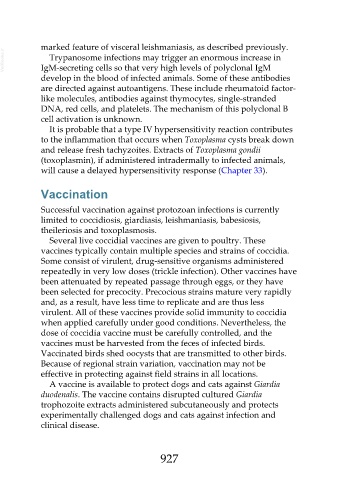Page 927 - Veterinary Immunology, 10th Edition
P. 927
marked feature of visceral leishmaniasis, as described previously.
VetBooks.ir IgM-secreting cells so that very high levels of polyclonal IgM
Trypanosome infections may trigger an enormous increase in
develop in the blood of infected animals. Some of these antibodies
are directed against autoantigens. These include rheumatoid factor-
like molecules, antibodies against thymocytes, single-stranded
DNA, red cells, and platelets. The mechanism of this polyclonal B
cell activation is unknown.
It is probable that a type IV hypersensitivity reaction contributes
to the inflammation that occurs when Toxoplasma cysts break down
and release fresh tachyzoites. Extracts of Toxoplasma gondii
(toxoplasmin), if administered intradermally to infected animals,
will cause a delayed hypersensitivity response (Chapter 33).
Vaccination
Successful vaccination against protozoan infections is currently
limited to coccidiosis, giardiasis, leishmaniasis, babesiosis,
theileriosis and toxoplasmosis.
Several live coccidial vaccines are given to poultry. These
vaccines typically contain multiple species and strains of coccidia.
Some consist of virulent, drug-sensitive organisms administered
repeatedly in very low doses (trickle infection). Other vaccines have
been attenuated by repeated passage through eggs, or they have
been selected for precocity. Precocious strains mature very rapidly
and, as a result, have less time to replicate and are thus less
virulent. All of these vaccines provide solid immunity to coccidia
when applied carefully under good conditions. Nevertheless, the
dose of coccidia vaccine must be carefully controlled, and the
vaccines must be harvested from the feces of infected birds.
Vaccinated birds shed oocysts that are transmitted to other birds.
Because of regional strain variation, vaccination may not be
effective in protecting against field strains in all locations.
A vaccine is available to protect dogs and cats against Giardia
duodenalis. The vaccine contains disrupted cultured Giardia
trophozoite extracts administered subcutaneously and protects
experimentally challenged dogs and cats against infection and
clinical disease.
927

